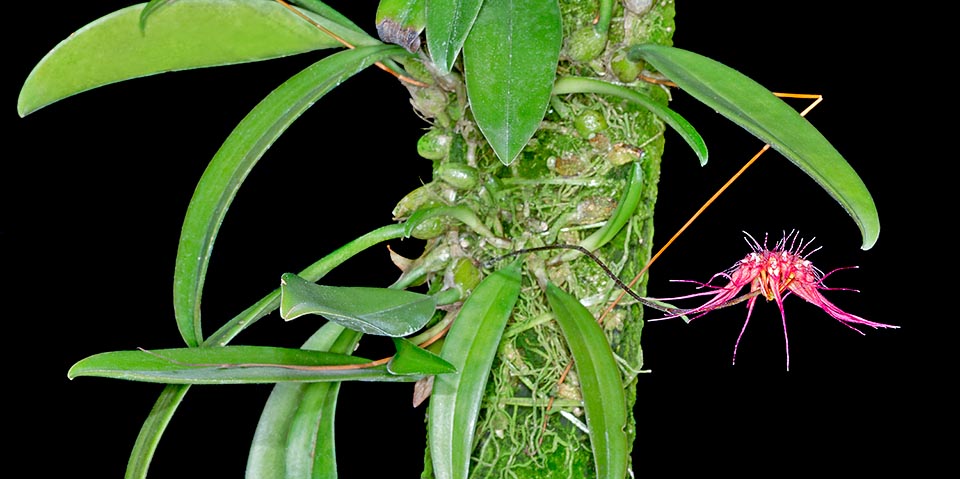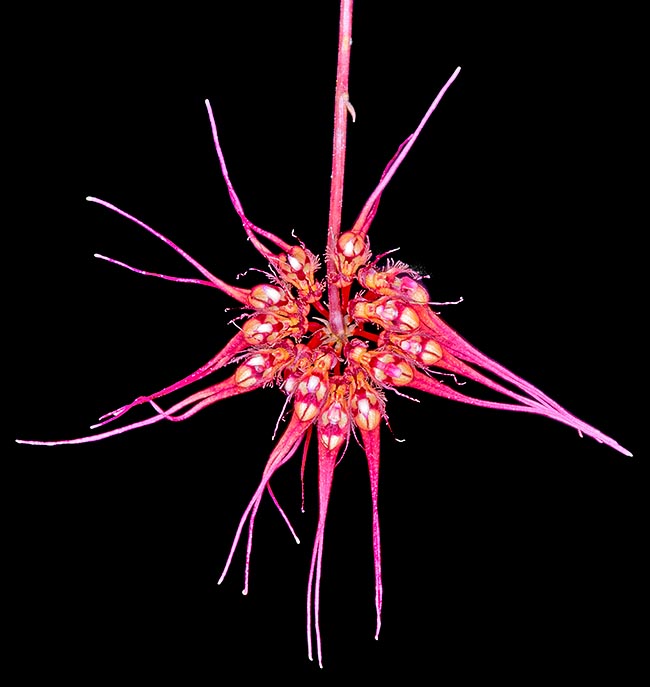Family : Orchidaceae

Text © Pietro Puccio

English translation by Mario Beltramini

Bulbophyllum gracillimum is an epiphytic miniature orchid of South-East Asia. Ovoid pseudobulbs, 0,5-1,8 cm long, on creeping rhizome, with 3,6-12 cm leaf © G. Mazza
The species is native to Australia (Queensland), Borneo, Fiji, Java, Moluccas, New Caledonia, New Guinea, Peninsular Malaysia, Salomon Islands, Singapore, Sumatra and Thailand where it lives in the humid forests at low altitudes in rather windy areas.
The name of the genus is the combination of the Greek substantives “βολβός” (bolbos) = bulb and “φύλλον” (phyllon) = leaf, with refrence to the leaves that grow at the apex of the pseudobulbs; the specific name is the superlative of the Latin adjective “gracilis, e” = frail, thin, with reference to the floral scape.
Common names: wispy umbrella orchid (English).
The Bulbophyllum gracillimum (Rolfe) Rolfe (1907) is an epiphytic species with ovoid pseudobulbs, 0,5-1,8 cm long and of 0,4-0,8 cm of diameter, spaced of 1-2,5 cm on a thin creeping rhizome rooting at the nodes and provided at the apex of only one obovate-elliptic leaf with bilobed obtuse apex, coriaceous, 3,6-12 cm long and 1-2,5 cm broad, of intense green colour.

Umbrelliform inflorescence on purple filiform scape bearing up to 10 flowers slightly scented arranged in circle. The dorsal sepal is ovate, with long pointed apex, red at the apex and yellow at the base. Thin and pink lateral sepals. Violet purple lanceolate petals. Easy to grow species in suitable climate with always moving air © Giuseppe Mazza
Miniature orchid with the characteristic inflorescences that move at the least breeze, floriferous and easy to cultivate, requires a partially shaded position, medium-high temperatures, with lowest night winter ones not under the 15 °C, high ambient humidity, 65-85%, and always moving air.
Frequent waterings and nebulizations, using rain water, by reverse osmosis or demineralized, and fertilizations, during the vegetative period, with hydrosoluble balanced products, with microelements at ¼ of the dosage suggested on the package. Preferably is to be mounted on trunks, on cork rafts or of roots of arborescent ferns, or, alternatively, on quite spacious earthenware pots or baskets, to allow the pseudbulbs to freely expand, with very draining and aerated compound, that may be formed by medium-sized bark fragments.
The species is inscribed in the appendix II of the CITES (species whose trade is internationally ruled).
Synonyms : Cirrhopetalum gracillimum Rolfe (1895); Cirrhopetalum microbulbon Ridl. (1896); Cirrhopetalum psittacoides Ridl. (1896); Bulbophyllum psittacoides (Ridl.) J.J.Sm. (1905); Bulbophyllum microbulbon (Ridl.) Ridl. (1907); Bulbophyllum psittacoides (Ridl.) Ridl. (1907); Bulbophyllum ruficaudatum Ridl. (1910); Cirrhopetalum leratii Schltr. (1911); Bulbophyllum leratii (Schltr.) J.J.Sm. (1912); Cirrhopetalum warianum Schltr. (1913); Cirrhopetalum le-ratii Kraenzl. (1928); Bulbophyllum nanobulbon Seidenf. (1974).
→ For general notions about ORCHIDACEAE please click here.
